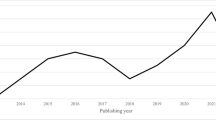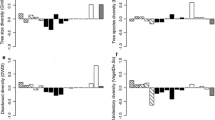Abstract
Context
Uneven-aged management systems based on selection silviculture have become popular in European mountain forests and progressively replace other silvicultural practices. In time, this trend could lead to a homogenisation of the forest mosaic with consequences on structural indices recognised as beneficial to forest biodiversity.
Aims
This study was conducted to investigate the potential effects of a generalisation of the selection silvicultural system on structural diversity in the forest landscape with consequences for forest biodiversity conservation.
Methods
We compared four structural indices (tree species richness, diameter heterogeneity, deadwood volume and basal area of mature trees) in five different stand types typical of the northern French Alps, using forest plot data in the Vercors mountain range. Through virtual landscape simulations, we then calculated predicted mean proportions of stand types under two different conservation strategies: (i) maximising mean index values at the landscape level and (ii) maximising the number of plots in the landscape with index values above given thresholds.
Results
Multi-staged forests did not maximise all indices, the best solution being to combine the five stand types in uneven proportions to improve biodiversity conservation.
Conclusion
The expansion of selection silviculture in European heterogeneous forest landscapes could enhance biodiversity conservation if other stand types with complementary structural characteristics are maintained.



Similar content being viewed by others

References
Angers VA, Messier C, Beaudet M, Leduc A (2005) Comparing composition and structure in old-growth and harvested (selection and diameter-limit cuts) northern hardwood stands in Quebec. For Ecol Manag 217:275–293
Ares A, Shanti B, Puettmann KJ (2009) Understory vegetation response to thinning disturbance of varying complexity in coniferous stands. Appl Veg Sci 12:472–487
Bagnaresi U, Giannini R, Grassi G, Minotta G, Paffetti D, Pini Prato E et al (2002) Stand structure and biodiversity in mixed, uneven-aged coniferous forests in the eastern Alps. Forestry 75:357–364
Barbier S, Chevalier R, Loussot P, Bergès L, Gosselin F (2009) Improving biodiversity indicators of sustainable forest management: tree genus abundance rather than tree genus richness and dominance for understory vegetation in French lowland oak hornbeam forests. For Ecol Manag 258:S176–S186
Battles JJ, Shlisky AJ, Barrett RH, Heald RC, Allen-Diaz BH (2001) The effects of forest management on plant species diversity in a Sierran conifer forest. For Ecol Manag 146:211–222
Beese WJ, Bryant AA (1999) Effect of alternative silvicultural systems on vegetation and bird communities in coastal montane forests of British Columbia, Canada. For Ecol Manag 115:231–242
Bouget C, Duelli P (2004) The effects of windthrow on forest insect communities: a literature review. Biol Conserv 118:281–299
Bruciamacchie M (2005) Protocole de suivi des espaces naturels protégés. Ministère de l’Ecologie et du Développement Durable.
Bunnell FL, Huggard DJ (1999) Biodiversity across spatial and temporal scales: problems and opportunities. For Ecol Manag 115:113–126
Carey AB (2001) Induced spatial heterogeneity in forest canopies: responses of small mammals. J Wildl Manag 65:1014–1027
Chávez V, Macdonald SE (2010) The influence of canopy patch mosaics on understory plant community composition in boreal mixed wood forest. For Ecol Manag 259:1067–1075
Cordonnier T, Courbaud B, Berger F, Franc A (2008) Permanence of resilience and protection efficiency in mountain Norway spruce forest stands: a simulation study. For Ecol Manag 256:347–354
Decocq G, Aubert M, Dupont F, Alard D, Saguez R, Wattez-Franger A et al (2004) Plant diversity in a managed temperate deciduous forest: understorey response to two silvicultural systems. J Appl Ecol 41:1065–1079
Di Ciccio TJ, Romano JP (1988) A review of bootstrap confidence intervals. J R Stat Soc B 50:338–354
Fahrig L, Baudry J, Brotons L, Burel FG, Crist TO, Fuller RJ et al (2011) Functional landscape heterogeneity and animal biodiversity in agricultural landscapes. Ecol Lett 14:101–112
Fox J (2002) Bootstrapping regression models. Appendix to an R and S-PLUS companion to applied regression. Sage publications
Gauquelin X, Courbaud B (2006) Guide des sylvicultures de montagne—Alpes du Nord françaises. Cemagref, CRPF Rhône-Alpes, ONF
Hansen AJ, McComb WC, Vega R, Raphael MG, Hunter M (1995) Bird habitat relationships in natural and managed forests in the West Cascades of Oregon. Ecol Appl 5:555–569
Harrell FE (2001) Regression modeling strategies, with applications to linear models, logistic regression, and survival analysis. Springer, New-York
Haveri BA, Carey AB (2000) Forest management strategy, spatial heterogeneity, and winter birds in Washington. Wildl Soc Bull 28:643–652
Holm S (1979) A simple sequentially rejective multiple test procedure. Scand J Stat 6:65–70
Lassauce A, Paillet Y, Jactel H, Bouget C (2011) Deadwood as a surrogate for forest biodiversity: meta-analysis of correlations between deadwood volume and species richness of saproxylic organisms. Ecol Indic 11:1027–1039
Matthews JD (1991) Silvicultural systems. Oxford University Press, New-York
McArdle BH, Anderson MJ (2004) Variance heterogeneity, transformations, and models of species abundance: a cautionary tale. Can J Fish Aquat Sci 61:1294–1302
McElhinny C, Gibbons P, Brack C, Bauhus J (2005) Forest and woodland stand structural complexity: its definition and measurement. For Ecol Manag 218:1–24
McMullin RT, Duinker PN, Richardson DHS, Cameron RP, Hamilton DC, Newmaster SG (2010) Relationships between the structural complexity and lichen community in coniferous forests of southwestern Nova Scotia. For Ecol Manag 260:744–449
MCPFE (2003) Improved pan-European indicators for sustainable forest management. Expert level meeting of the Ministerial Conference on the Protection of Forests in Europe, Vienna.
O’Hara K (2009) Multiaged silviculture in North America. J For Sci 55:432–436
Økland B, Bakke A, Hågvar S, Kvamme T (1996) What factors influence the diversity of saproxylic beetles? A multiscaled study from a spruce forest in southern Norway. Biodivers Conserv 5:75–100
Penttilä R, Siitonen J, Kuusinen M (2004) Polypore diversity in managed and old-growth boreal Picea abies forests in southern Finland. Biol Conserv 117:271–283
Poirazidis K, Kati V, Schindler S, Triantakonstantis D, Kalivas D, and Gatzogiannis S (2010) Landscape and biodiversity in Dadia – Lefkimi – Soufli Forest National Park. In: Biodiversity, management and conservation. WWF Greece, Athens
Schall P, Ammer C (2013) How to quantify forest management intensity in Central European forests. Eur J For Res 132:379–396
Spies TA, Turner MGI (1999) Dynamic forest mosaics. In: Hunter ML (ed) Maintaining biodiversity in forest ecosystems. Cambridge University Press, Cambridge, pp 335–361
Uotila A, Kouki J (2005) Understorey vegetation in spruce-dominated forests in eastern Finland and Russian Karelia: successional patterns after anthropogenic and natural disturbances. For Ecol Manag 215:113–137
Vuidot A, Paillet Y, Archaux F, Gosselin F (2011) Influence of the tree characteristics and forest management on tree microhabitats. Biol Conserv 144:441–450
Werner SM, Raffa KF (2000) Effects of forest management practices on the diversity of ground-occurring beetles in mixed northern hardwood forests of the Great Lakes region. For Ecol Manag 139:135–155
Willson MF (1974) Avian community organization and habitat structure. Ecology 55:1017–1029
Acknowledgments
The map of forest stand structure was provided by the National Forest Office (NFO), and we thank all the local forest managers who contributed to the field work preparation. Several people assisted in the field, and this research could not have been done without their help. We especially thank Marc Fuhr, Eric Mermin, Gilles Favier, Pascal Tardif, Sophie Labonne, Romain Verger, David Thomasset and Jonathan Charles. Special appreciation goes to Valentine Lafond for her comments that helped us in improving the manuscript as well as Ron Smith from the Centre for Ecology and Hydrology who helped with valuable comments and the editing of the final manuscript. We also thank the anonymous reviewers, the editor and the associate editor for their valuable comments that also strongly helped to improve the manuscript. This research was conducted on the long-term research site Zone Atelier Alpes, a member of LTER France.
Funding
This work was financially supported by a graduate student research fellowship to M. Redon from Grenoble University, France, and by funds from the FORGECO project (ANR-09-STRA-02-01).
Author information
Authors and Affiliations
Corresponding author
Additional information
Handling Editor: Laurent Bergès
Contributions of the co-authors
Mathilde Redon: selecting structural indices, designing the experiment and doing field work, ranking of stand types according to the results of statistical analysis and writing the paper.
Sandra Luque: supervising the work and revising the paper.
Thomas Cordonnier: supervising the research project, designing the experiment and doing field work, performing the simulation study and writing the paper.
Frédéric Gosselin: performing statistical analyses and writing corresponding parts; revising the paper.
Electronic supplementary material
Below is the link to the electronic supplementary material.
Appendix S1
(DOC 100 kb)
Rights and permissions
About this article
Cite this article
Redon, M., Luque, S., Gosselin, F. et al. Is generalisation of uneven-aged management in mountain forests the key to improve biodiversity conservation within forest landscape mosaics?. Annals of Forest Science 71, 751–760 (2014). https://doi.org/10.1007/s13595-014-0371-7
Received:
Accepted:
Published:
Issue Date:
DOI: https://doi.org/10.1007/s13595-014-0371-7



